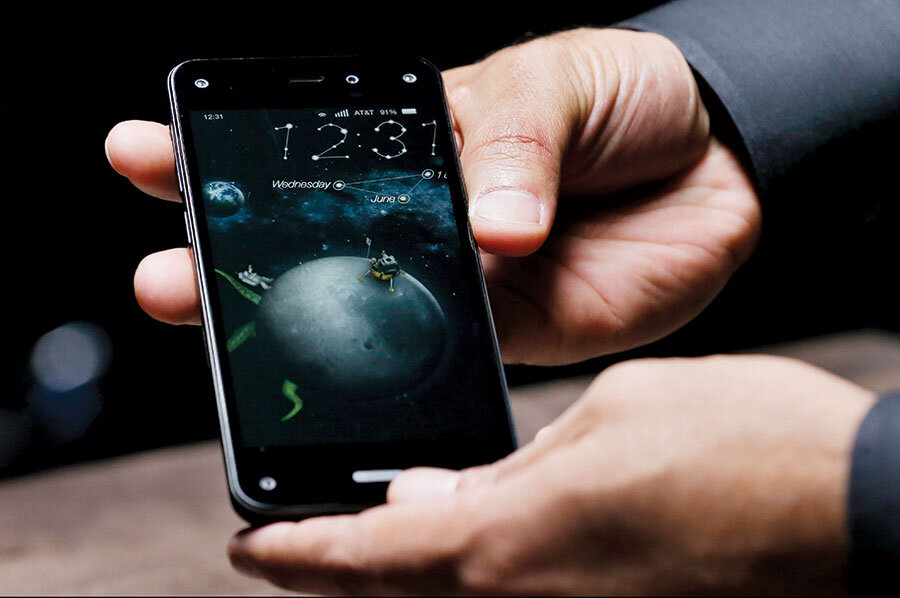Amazon Fire: Game-changer or dud?
Loading...
The reviews are in for Amazon's Fire phone. The retail behemoth's entry into the smartphone game pits the Seattle-based company against the dominant players of Samsung and Apple. Now, the question on everyone's mind? What kind of chance does Amazon stand in this fierce market?
The phone begins shipping this Friday, and it's loaded with a whole slew of bells and whistles touted last month by Amazon chief executive Jeff Bezos at event to unveil the device.
They include:
- Dynamic Perspective: a series of sensors allowing the phone's screen to respond to the head movements of users and creates the sensation of 3-D imaging.
- Firefly: a feature that lets the phone identify real-world items – and give users the option of heading to the Amazon store to buy said items.
- Mayday: a built-in service that quickly connects users with tech support.
To be sure, there are ample more features. There's the 4.7-inch screen, the HD 1280x700 resolution, the 32 gigabytes of storage, and the yearlong subscription to Amazon Prime that comes bundled with your purchase of Fire, giving you discounted shipping and access to a slew of movies and TV shows.
But reviews of the device have been mixed. The conclusions seem to be that while it's a good phone (especially if you're an Amazon devotee), it's nothing to write home about. We'll have to wait a bit longer to see how the device actually performs among users. For now, let's break down how it's been received by reviewers.
Writing in The New York Times, Farhad Manjoo explains that underneath the fancy exterior, which does not impress him, the phone is "solid." He writes:
"Amazon’s focus on the Fire Phone’s flashier side is unfortunate, because when I dug beneath the gimmicks, I found something better than 3-D heroics. The Fire Phone is uncommonly friendly and easy to use. As a bare-bones smartphone, it should prove especially attractive to people who find themselves overwhelmed by today’s crop of do-it-all superphones. When you forget about its whiz-bang marketing, the Fire begins to stand out as something much more interesting: a phone for the rest of us."
Geoffrey Fowler, meanwhile, writing in The Wall Street Journal, takes a harsher tack, calling out the phone for a poor-quality camera, weak battery, and the lack of Google's Play app store, among other reasons. Among his grievances, are Amazon's brazen attempts to get users to purchase what is clearly an all-in-one Amazon shopping device. He writes:
"The Fire does some things well. None is a reason most people would switch. The screen holds up adequately in sunlight and measures 4.7-inches, a great size to balance grip and thumb reach. The headphones include flat cable and magnetic buds that help prevent tangles. It also has a user interface that clears away the clutter and confusing layout of most Android phones, including easy-to-read panels that emerge from the sides and a home-screen "carousel" with big icons for your most-used apps. Too often, though, it wastes space under those icons recommending things for you to buy."
He summarily adds that "Amazon's first Fire isn't going to spark much."
On the other hand, Business Insider's Jillian D'Onfro found appeal in Dynamic Perspective, which was praised as one of the phone's signature achievements. She writes:
"The phone itself also takes advantage of dynamic perspective in fun, subtle ways: Every app icon on the phone looks like it has depth when you tilt it. The on-off switch in the Wi-Fi part of the settings pops out like a real button, and you can "visit" 3D-looking landmarks through maps. None of these factors would be your main motivator to buy the phone, but they prove that Amazon was paying attention to the details."
Because Fire runs its own version of Google's Android operating system, critics have pointed out that traditional Google apps like Maps, Drive, and YouTube are not available. But as D'Onfro points out, consumers likely to enjoy this phone are those most jazzed about living "in Amazon's world and don't need access to the latest and greatest apps and services rival devices offer."
And while Amazon has announced a list of apps that take advantage of Fire's new features, she notes, it's unlikely to attract new developers until the phone has proven itself as a moneymaker on the market.
The Fire sells for $199 with a two-year contract or for $650 with 24 monthly payments of $27.09. It is currently available only on the AT&T network.






